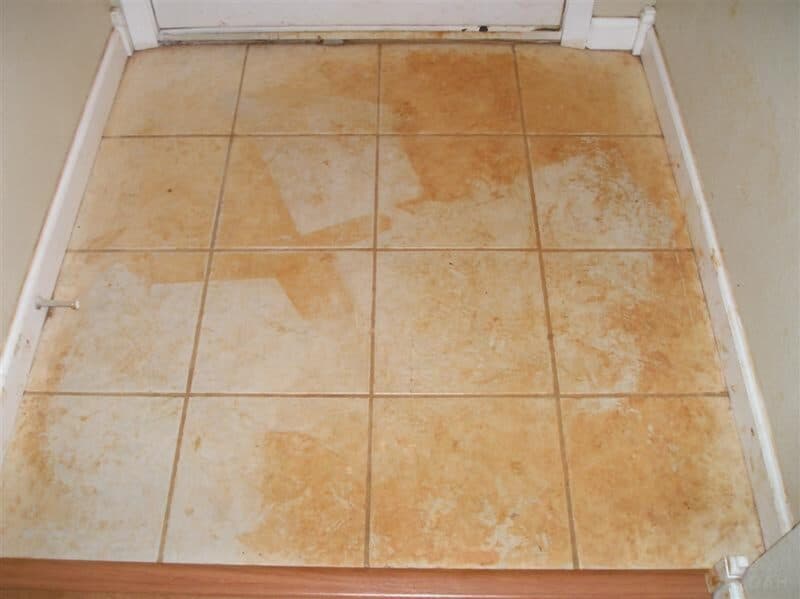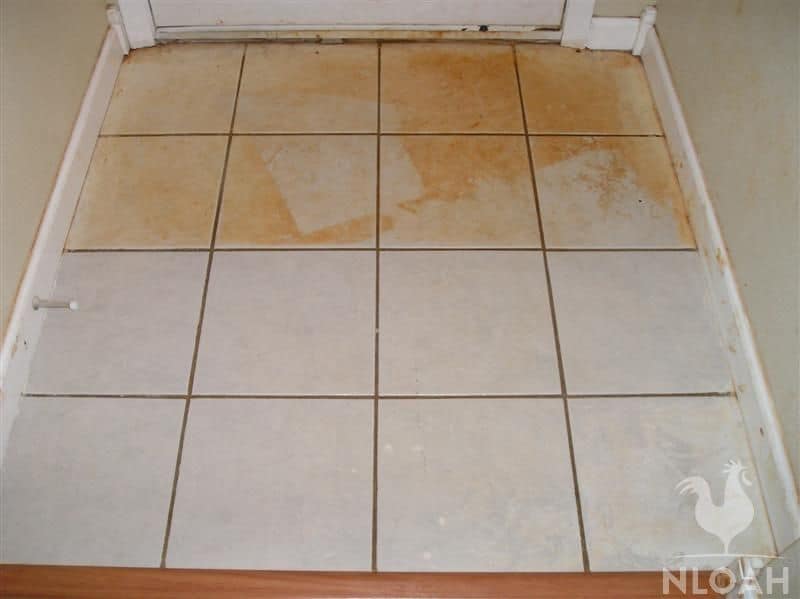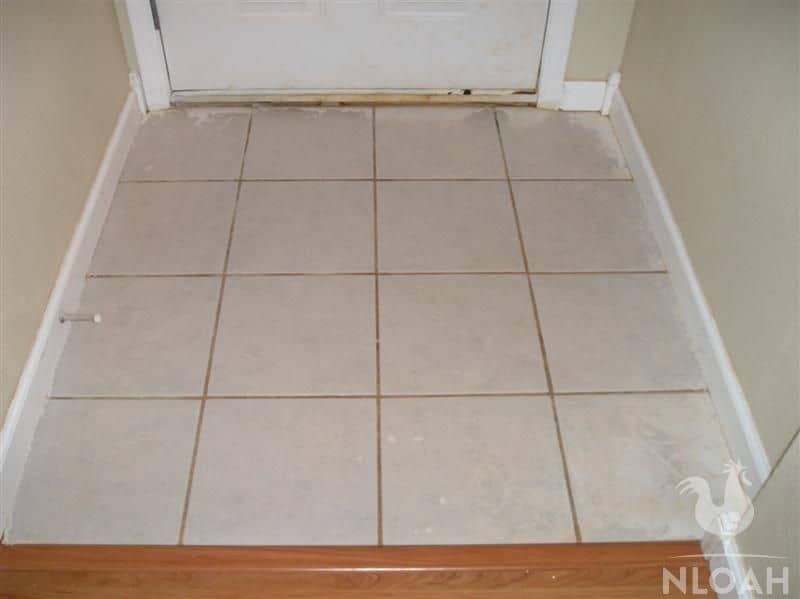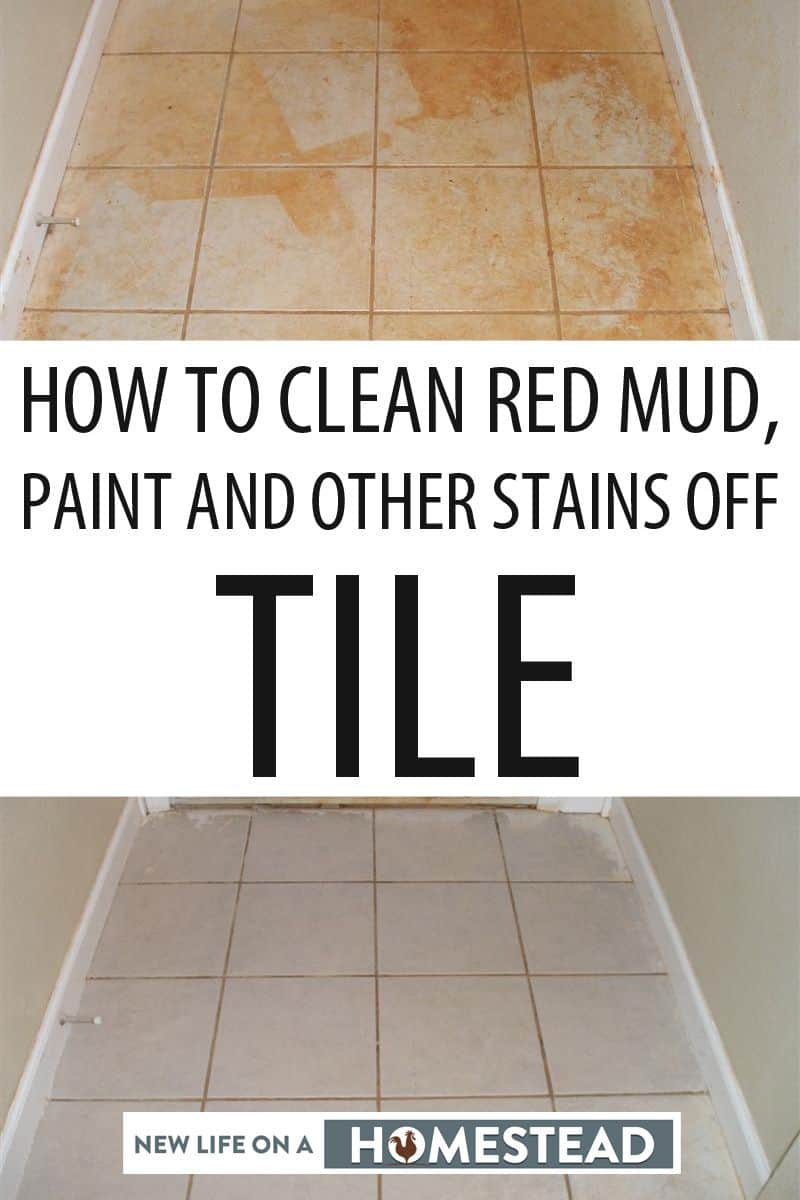See how horrible my entryway floor looked? It’d been this way since we moved in two years ago. Despite my desperate attempts to scrub it clean.
Some genius sprayed kilz or something over the tile in my entryway and laundry room, and sealed in the red mud stains. I thought I’d NEVER get it clean.

That is. Until yesterday.
We’re hosting a Bible study here tonight, so I’ve been cleaning like crazy. Okay… there might be a little bit of obsessive nesting mixed in as well.
Now, the thing about tile is that it is supposed to be much easier to clean. Unlike other kinds of flooring, like carpet, tile is known for shedding dirt and oil and being, well…just easier to maintain!
However, it had been some time since my tile floors had seen any TLC, and it was starting to show – and to seriously aggravate me!
Needless to say, the stained tile was driving me nuts. Here are a few ways you can clean red mud, paint, and other stains off tile – easy.
Try Standard Solutions First
Now, before you go trying any of the methods I”ll include in this article, I’d like you to double check the floor manufacturer’s guidelines to see what, exactly, is recommended for you to use on your tile stains. That’s because some kinds of tile stain removal products, whether homemade or not, aren’t safe for all floor types.
For example, while vinegar is safe on many kinds of flooring, that’s not the case for marble floors. Therefore, it’s important that you always do research on your specific floor type (including by the manufacturer) to make sure the cleaner you intend to use is safe for your floors.
Before you try anything (and this will sound obvious!) try to wash the area with some hot water and your typical cleaning product first. Don’t break out the big guns unless you absolutely need them! If, however, after your usual cleaning regimen, the stains are still there, feel free to give some of these DIY solutions a try.
Club Soda
Yep, good ol’ club soda to the rescue! This is particularly helpful when it comes to getting grease stains out of tile. The key here is that you have to use fresh club soda – you can’t use flat soda. The carbonation is what will help cut the grease. Use it on a clean rag with some hot water.
Diluted Bleach
If you decide to use diluted bleach on your floors, use about ¾ cup bleach to one gallon of water. You only need a few drops if you’re spot-cleaning stains but you can also use this to clean your entire floor – just keep a few windows open so you don’t make it tough to breathe in there!
To do this, saturate a cloth with diluted bleach and put it on the stain. Leave it there for about 15 minutes (or until the stain is gone, whichever comes first). Rinse with hot water.
Ice
This is a great method for getting tar, wax, and gum off tile. All you have to do is apply some bagged ice cubes or even a commercial ice pack to the stain. Allow it to sit there until the staining substance is cold and has solidified. Use a wooden craft stick to remove as much of the substance as you can, but be careful, as this could scratch your tile if you aren’t careful.
Wipe it down with paint thinner and try not to get any on your grout. Then, rinse with water and dry.
Vinegar
Vinegar won’t work on many tile stains, but it does work well on hard water. The mineral deposits from hard water can be tough to get out otherwise. To get rid of hard water stains, use a roll of paper towels and a bottle of white vinegar. Saturate the towel with the vinegar and place them on the affected tiles. Let them sit there for about eight hours.
Then, lift the towels away. You should see a difference, but if not, repeat until your tiles look clean.
Again, don’t use vinegar on marble tiles or natural stone tiles if you don’t test them first – or best yet, check with your manufacturer to see if vinegar is safe to use.
Hydrogen Peroxide
Hydrogen peroxide is particularly effective at getting things like tea, coffee, fruit juice, and wine out of tile. Just saturate a cleaning rag with a bit of the solution then apply it to the stain. Make sure you rinse thoroughly afterward.
Hydrogen peroxide works really well with permanent markers, too, but you’ll have to get more aggressive in your approach. First, saturate the cloth with hydrogen peroxide and put it on the stain.
Blot the ink up with the cloth, pressing as firmly as you can. Each time you reapply the cloth to the stain, make sure you use a clean portion so you don’t have to worry about spreading the stain.
This can take some time, and you’ll have to rinse with water afterward. If there’s any ink residue remaining, you can apply a few drops of an oxygen-based cleaner (like the type that bubbles up) to the residue and scrub it with a soft brush. Allow it to sit for about 15 minutes before you rinse and dry.
Dry Eraser
Is there anything a dry eraser cleaning sponge isn’t good for? Try rubbing it with a dry eraser sponge then wiping down with warm, soapy water. This method works great for permanent marker stains – something the kids seem to be oh-too fond of!
Getting Stains Out of Grout
If you have tile, you probably have grout – but unfortunately, removing stains from grout is a whole new beast altogether. That’s because grout is super porous and actually absorbs stains, making them super difficult to remove. Stained grout can make the whole room look dirty, even if the tiles are brand-new.
You can use a mixture of vinegar and hot water to get dirt out of grout (tip – use an electric toothbrush at the highest setting to loosen up ground-in dirt!) or you can try sandpaper. You’ll only want to use the sandpaper around the stained grout line, though, of course.
Another way you can get stains out of grout is to use a pencil eraser! Just move back and forth with the eraser until the stain has disappeared, then rinse with hot water. You can also use baking soda or peroxide, which is perfect for porous tile, like marble. You won’t have to use vinegar or some other caustic material.
Scouring Powder
Scouring powder can also help get liquid floor stains out. To use it, you will need to first wet the stain with water, then sprinkle some scouring powder on the floor to cover the stain completely. Mix the scouring powder in with water and let the paste sit there for a moment. WIpe it away with a rag.
This solution works best on floor stains like grease, food, and water marks. If this method does not work for you, make sure you dry and clean the area thoroughly before trying something else, as it can react with other cleaners.
Borax
What homestead doesn’t have borax lying around? This popular cleaning agent does a great job of cleaning clothes and can also help you clean up the kitchen.
Combine a cup of Borax with a quarter cup of water before using a sponge to scrub the stain. Only use this method on finished tiles, though, like porcelain, ceramic, or marble.
Peppermint Oil
Peppermint essential oil won’t always work well by itself, but when combined with equal parts of rubbing alcohol, white vinegar, water, and ½ a teaspoon of liquid dish soap, a few drops of peppermint essential oils can provide just enough chutzpah to get those stains off your floor. Plus, the peppermint will smell great, and it will deter mice and ants.
Lemon Juice
If you have finished tiles, you can use lemon juice to scrub away hard water stains. Just spray a bit onto the stain and scrub until it’s lifted.
Ammonia
I really don’t like using chemicals on my floor, but I should begrudgingly admit that, for some stains, ammonia is the way to go. It’s particularly effective on mildew.
Combine a 50-50 mixture of ammonia and water. Scrub the area with a soft brush and ammonia then rinse with clean water. Make sure you wear gloves and keep the room aerated until you’re done, though.
Muriatic Acid
I’ll be honest – this is not my favorite solution for getting stains out of tile. It can be pretty caustic, but if you’re stuck and can’t get any of these other solutions to work, it could be an option for you.
Muriatic acid has been used by cleaning professionals for many years. You’ll need to ventilate the area and be careful, wearing eye protection, a mask, and heavy gloves.
To use it, you’ll dilute the acid to one part acid to five parts water. Pour the acid into the water and not the other way around to prevent injuring yourself. Apply the mixture, then scrub the area. Wash it with water and discard all of the remaining mixture in a safe way.
What Worked For Me: Jerry’s Orange Scented Hand Scrubbing Solution
After mopping and scrubbing and nothing really making any difference, it suddenly occurred to me to try Jerry’s orange scented hand scrubber stuff. It gets oil and gunk off… I figured it might work!
After checking out the back of the bottle I found that not only is it good for cleaning dirty hands, it’s also great for removing laundry stains and general household cleaning needs. Yeah, but could it clean my tile? It promised to remove soils and paint among other things, so I thought I’d put it to the test.
I squirted a small amount of the cleaner onto one tile square, and using a scrubby sponge, I scrubbed in a circular motion.
And what do you know? My tile was actually white under there.

I cleaned half of the floor to see the difference. I was so excited, I called the kids over to see. Jada was sweet and humored me by sharing in my amazement.
But seriously. Look at that!
I scrubbed and scrubbed some more until each and every tile sparkled like it was brand new again.

I LOVE THIS STUFF!
Oh, if you guys only knew how utterly impossible this job seemed to be!
It’s called Fast Orange, and although it isn’t all natural, it is nontoxic, biodegradable, and smells SO good.
If you have stained tile I’d highly, highly recommend giving this a try. I still have to touch up the corners, but I just can’t get over how well this cleaner worked. It’s my new favorite.
Prevent Stains to Tile in the First Place
As they say, an ounce of prevention is worth a pound of cure! The best way to get stains out of tile is to stop them from getting there in the first place. Easier said than done, though, right?
While you can’t prevent accidental spills and fumbles, you can reduce the likelihood of long term staining by cleaning your tile floors at least once a week or once every two weeks.
In addition to routine mopping, you’ll also want to sweep or vacuum. This will prevent dirt, grit, and grime from penetrating into the tiles and damaging your beautiful floors.
When you’re cleaning your floors, avoid using things like hard wire or bristle brushes and steel wool pads – these cna scratch your tile. You should also avoid using any chemicals that might interact with each other (ammonia is notorious for this).
Chemicals that produce fumes need to be avoided if possible, too, and if you absolutely have to use them, make sure pets and kids are kept away.
If you do have an accidental spill to contend with, clean it up immediately. Don’t let it sit there or it can discolor your tile.

updated 08/11/2020 by Rebekah Pierce

A city girl learning to homestead on an acre of land in the country. Wife and homeschooling mother of four. Enjoying life, and everything that has to do with self sufficient living.

You beautiful lady! I thought I had tried everything! Nothing worked as well as this! Thank you!!!
I am distraught over staining my beautiful ceramic counter tops with red clay. I put a container of water that I had been using during clay class on the counter without a top of course and my husband knocked it over while doing dishes. I hope I can find these products at my local WalMart. I live in Mexico.
Anonymous- do you have Mr. Clean Erasers there? I’d try that. Good luck!
Where can I get that at to try on mine?
Renee,
Maybe try a hardware store? Lowes or Home Depot?
Awesome results! Where do you find Fast Orange?!
Annette,
I’m pretty sure it was from Walmart.
So glad to hear from you. I did not have any Fast Orange. i DID HAVE A ONE DOLLAR BOTTLE OF aWSOME, FROM dOLLAR gENERAL. i SPRAYED IT ON A DRY FLOOR. uSED A SCOWER DRY PAD WIPED EACH SECTION WITH A WET/SHAM. wONDERFUL rESULTS. mO WASHING OUT A MOP JUST THE SHAM. i JUST CAME IN FOR LUNCH. mY dOGHOUSE IS 16 BY16 FEET. tWO STORY. i JUST WORKED ON UPSTAIRS. tHANKS pATTY i RAISE kING carles Cavaliers.
Did you use this on a dry or wet floor. What did you use to get up the excess cleaner. Again, wet or dry I have a large floor to clean and need all the help i can get. Thanks
Patty,
I scrubbed the dry floor, then used a wet rag to wipe it up 🙂
I know this is a really old post, but I just read it and wanted to share my experience. In our old garage apartment we had a white vinyl tile entry that was horribly stained. I used straight-up bleach cleaner spray (the kind from Dollar Tree) on it! Worked like a champ. I know some people do not like chemicals, and even if you’re okay with them, the bleach smell *is* overwhelming – Simple Green is another good alternative. It is natural and works wonders, and has a nice minty fragrance.
That’s awesome! Congrats on that!! I have known foam (not the gel) shaving cream to work as well.
Wow! That is quite a transformation! I’ll have to keep that in mind. My dad uses that stuff to scrub up after he’s been working on cars.
Oooooooooomigoodness, that is UH-MAZING. Seriously… I’m so happy FOR you. LOL, it really is the simple things in life that bring the most joy. 🙂
This is brilliant! I was looking for something to clean the shower pans because of the years of accumulated dirt I could not get out of the texture. Bleach would not do it and I did not want to use those horrible chemicals.
I just tried it and it works with a lot of “elbow grease”. So I got out my mini mouse sander and put the nylon scrub pad on it and IT WORKS like a dream. I am careful not to get shocked. 🙂
Thanks for the idea. I had a huge container of Gojo that was YEARS old under the sink and it was perfect.
Rosann,
So glad it worked well for you! I found that if I squirt it on, rub it around to cover the surface, and then allow it to sit and penetrate the stain for about 5 min. or so, the scrubbing is SO much easier!
Is that a regional product? I can’t find it anywhere, even on the internet. Could you show a photo of the front of the package? Thanks !!!
Deb W,
It’s the same thing as Gojo, if you have that 🙂
Oh my gosh! Who knew? I NEVER would have thought of that…in a million years. It looks so nice and welcoming now!!
Did it not scratch the tile? It says that it has pumice in it.. IF not… that is pretty awesome.
Jennifer,
Nope. Didn’t scratch it whatsoever 🙂 Nor did it dull the glossy finish. Just got up the dirt! The grit is so fine… it’s no worse than using baking soda.
WOW – I thought your tile was just “SUPPOSE” to look like that (from the photo :)…AMAZING!!! I’ve GOT to check into some of that…especially for one of my FAVORITE shirts that has a grease food stain on it…waah! 🙂
Love that stuff! It’s the only cleaner I’ve found that will take oil/grease marks from food out of clothing. I have to let my sister know about tile though…hers drives her NUTS with the red mud.